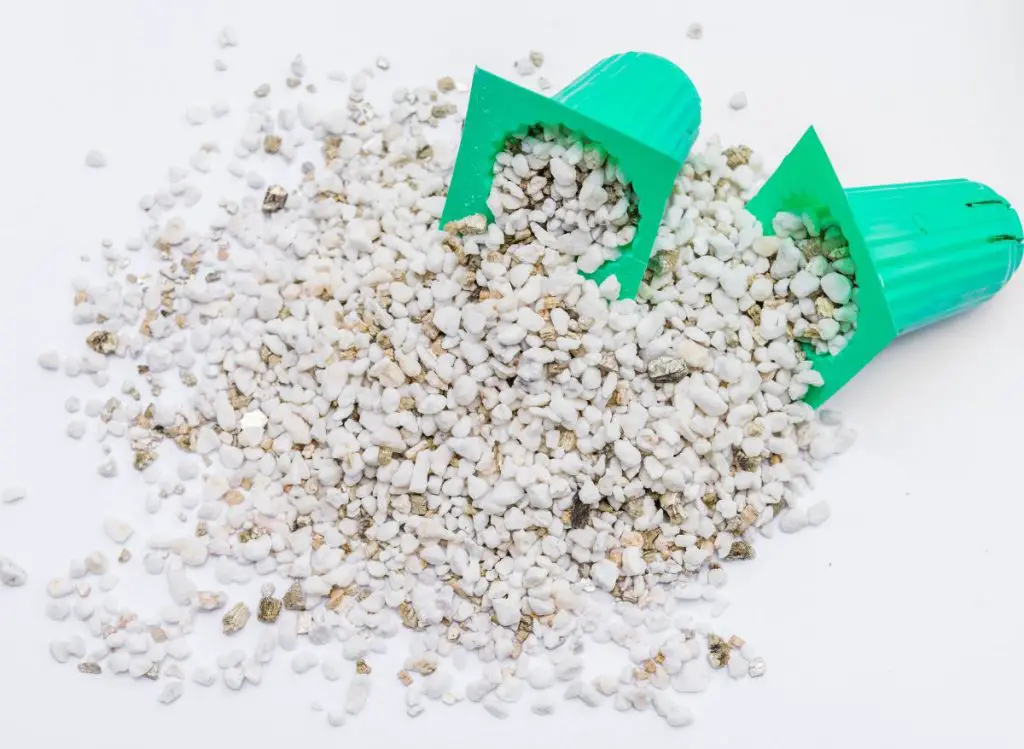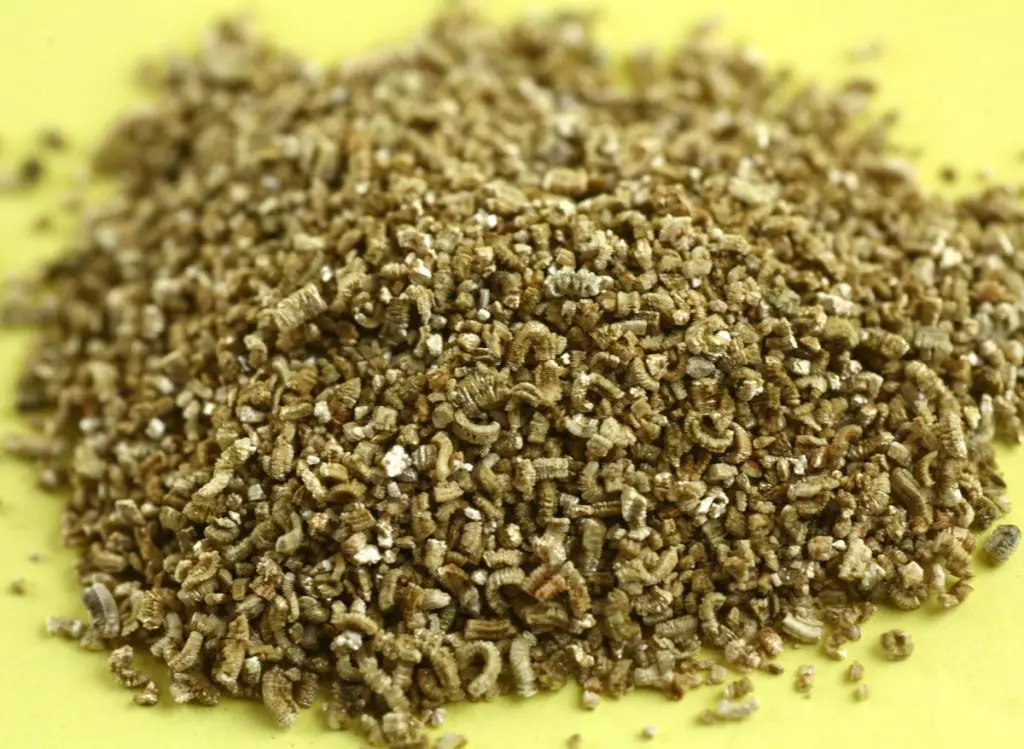Hydroponics is a cultivation technique that involves growing plants without using soil. Instead, you should use another substrate to act as the growing medium and provide support. Perlite and vermiculite are two popular substrates you can choose from. But, perlite vs. vermiculite hydroponics, what are the differences?
Vermiculite will integrate with soil and help to retain water. In contrast, perlite will add drainage to the soil combined with. Vermiculite is an excellent seed-starting system. They both have a stony appearance but differ significantly in their features.
If you’re wondering about perlite vs vermiculite hydroponics, you no longer have to. This post will allow you to learn the differences between these mediums to choose the best one for your needs.
See also: Can You Grow Hydroponic Basil In Soil? (Find out now!)
What Is Perlite In Gardening?
Perlite is created from a volcanic rock that bursts into multiple pieces upon heating and crushing (Source: Oklahoma State University). These little white pieces can be added to a planting container to support and enhance other growth factors. The final small rocks are lightweight with many air pockets.
You should also remember that perlite is white and resembles Styrofoam pieces. So it can easily turn into powder in your hand if you put too much pressure. Luckily, this issue does not occur in pots because the pressure is insufficient.

What Is Vermiculite?
Vermiculite is another growing medium that is mined from rocks. It is a mineral that changes shape upon heating (Source: Oklahoma State University). However, it does not pop or explode like perlite. Instead, the material gains a worm-like shape and contains multiple layers.
This material is also easy to identify because of its distinctive gray-brown color. Depending on the conditions, it may also be yellow, gold, or copper. The growing medium is lightweight and odorless to offer sufficient support to plants.

Perlite Vs Vermiculite Hydroponics: What Are The Differences?
Here are the top differences between perlite and vermiculite hydroponics:
1- Origin
Perlite is derived from a volcanic rock that pops into pieces when heated. This classifies the final material as solidified magma type. Because of this, perlite is also referred to as volcanic glass by some gardeners.
Meanwhile, vermiculite is a clay-based mineral that can be mined from rocks. Russia and Africa are two famous countries where this growing medium is mined. The extracted vermiculite is heated in furnaces to release its water content.
These different origins determine the properties of these growing mediums. This is why you must remember this difference.
2- Physical Features
The physical features of these growing mediums differ because of their varying properties. For example, perlite is white and resembles the texture of Styrofoam. Meanwhile, vermiculite can have three to four colors. The most prevalent one is gray-brown.
You may also encounter a silver-gold color or yellow shade. Sometimes vermiculite may also have a copper appearance. This property mainly depends on the mining region and conditions. The shape of these growing media is also different.
Perlite is small and round, while vermiculite is slightly more elongated than this medium. It has a worm-like appearance after heating and resembles the texture of tree bark pieces.
So vermiculite is slightly larger and more solid than perlite.
3- Water Holding Capacity
Water holding capacity is an essential factor to consider when choosing a growing medium. If the capacity is not correct, you may kill your plant unknowingly. Perlite has lower water holding capacity than vermiculite.
Both materials are porous, but vermiculite is less porous and more compressible. This is why it retains water better than perlite. Its porosity allows it to absorb water easily and hold it for an extended period. So the plant will never be underwatered.
Meanwhile, perlite dries promptly, so you must water your plant frequently to meet its needs. That is why this growing medium is not suitable for cultivating plants with high water requirements.
4- Weight
The porosity and water holding capacity also affect the weight of the two growing mediums. Perlite is less heavy than water and can float on it. Meanwhile, vermiculite does not have this capability.
This feature significantly impacts plant health if you mix the medium with potting soil for growth. Vermiculite retains moisture to maintain the best germination conditions for seeds.
That is why it is also best for outdoor plants, unlike perlite, which can cause the seeds to dry out. You can also use the medium for repotting.
5- Aeration Capability
Perlite is less porous than vermiculite but offers more aeration than vermiculite. The latter medium becomes compact when you water it, so the aeration capacity reduces. This also happens if you mix vermiculite with your potting soil for other cultivation techniques.
Some plants require more airflow while others do not. If your species require good circulation, it is best to use perlite. The growing medium will enable the air to reach plant roots.
So you can ensure healthier growth by considering the growth factors and the medium’s features. High aeration capacity allows the medium to reduce the risk of mold and root rot.
Pros And Cons Of Using Perlite
Here are the pros and cons of perlite:
Pros Of Using Perlite
- Perlite is suitable for creating seed mixes and blending with potting soil
- It loosens compact soils to improve air circulation
- Clean, non-toxic, and odorless
- Neutral pH ensures the medium does not affect the plant negatively
- High aeration capacity for hydroponics
- It allows easy drainage of excess water
Cons Of Using Perlite
- It is not highly porous, so the medium has low water holding capacity
- Only suitable for drying out the soil
Pros And Cons Of Using Vermiculite
Here are the pros and cons of vermiculite:
Pros Of Using Vermiculite
- Suitable for blending with soil mixes
- It retains moisture well to offer essential nutrients to plants
- Mixes very easily with different soils
- Non-toxic, odorless, and clean
- Vermiculite has a neutral pH
- High water holding capacity to create well-drained soil for water storage
Cons Of Using Vermiculite
- It does not have high aeration capacity
- A bit heavier than perlite
Perlite Vs Vermiculite Hydroponics: Which One Should You Choose?
In perlite vs vermiculite hydroponics, you must consider the growing conditions of your plant to choose the correct medium. The best material for cultivating plants with high water needs is vermiculite. This medium retains water long enough for the roots to absorb it.
However, you must also ensure your plant does not require high airflow when using vermiculite. The low aeration capacity of the medium will negatively affect the plant.
Meanwhile, perlite is mainly suitable for plants that require the soil to dry completely between watering sessions. So you can easily use it for growing cactus and some succulents. The high aeration capacity also allows the plant to drain excess water.
See also: Perlite And Pumice: Which One Should You Pick?
Can You Reuse Perlite In Hydroponics?
Perlite can be reused by cleaning and sterilizing it again before adding it to the plant bed or pot. However, this is not advisable because salt accumulation can occur due to reuse. Besides that, pest contamination and medium compaction are also more frequent when you reuse perlite.
So while you can reuse perlite, you should avoid doing so to maintain your plant’s health. The growing medium must be replaced after every one or two years to avoid crop failure. If you still want to reuse perlite for hydroponics, you must process it properly before adding it to pots again.
Can Vermiculite And Perlite Be Used Interchangeably?
Perlite and vermiculite are generally used to improve soil moisture retention and aeration. You can use perlite and vermiculite the same way, but it is not recommended to use them interchangeably. Perlite and vermiculite differ in composition and how they improve your soil.
Perlite and vermiculite are lightweight soil substitutes in hydroponic systems, often used to enhance aeration and texture in potting and garden soil mixtures. Both perlite and vermiculite are sterile, odorless, insect-free, disease-free, and seed-free.
See also: 6 Best Hydroponics Fertilizers For Faster Plant Growth!
Final Thoughts
This is your complete guide to perlite vs vermiculite hydroponics. The two mediums are used for creating different plant growing conditions. Vermiculite is best for well-drained soil, while perlite is suitable for well-aerated soil.
Perlite is also a better material if you want to avoid overwatering your plant with low water needs. Comparing the differences with your plant species requirements will help you choose the best material.


